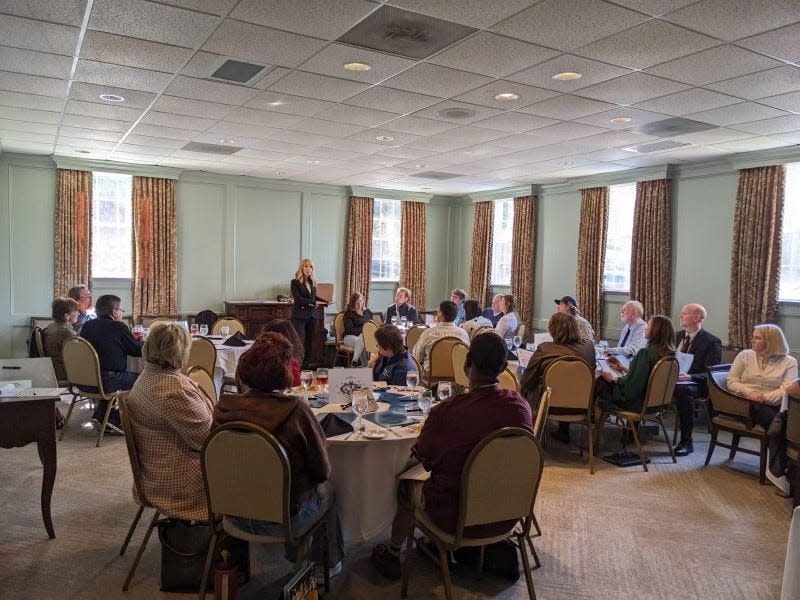Grant to Gadsden City Schools will help create local STEM ecosystem
Gadsden City Schools got a grant to create a local STEM Learning Ecosystem, but the impact — and, hopefully, the benefits — will be felt beyond a single school system.
The $50,000 grant is from the Alabama STEM Council, and the Gadsden City system was one of 24 recipients chosen from 87 applicants statewide.
And what are the ecosystems they're supposed to promote?

“It's bringing all STEM resources and the regional workforce together,” said Lana Bellew, the system's grant writer, “so that you're not duplicating services and you're making everyone aware of the STEM resources that we have in our region.”
The Alabama Stem Council website describes it as fostering “collaboration among businesses, K-12 schools, higher education institutions, government entities, out-of-school time providers, philanthropic organizations and more.”
Ideally, the payoff will be better-educated students who are more prepared for a modern workforce where science, technology, engineering and math are increasingly prioritized.
“STEM education is a critical component to future job preparedness for our students,” said David Asbury, director of human resources, career tech and technology for the Gadsden City system. “Although we like to throw in an 'a' for the arts, which we think are very important, in our school system anyway.”
About 30 of the potential stakeholders in the ecosystem met Feb. 15 at the Gadsden Country Club to exchange ideas and catalog what they each had to offer. The group included officials from the Etowah County and Attalla school systems and Gadsden State Community College, plus representatives of business and industry, the Challenger Center that's being developed in Rainbow City, the Gadsden Cultural Arts Foundation and the Gadsden Public Library.
“Everybody met and asked 'what do you do' and 'what do you have?' ” Bellew said. “It was almost like a meet and greet. They had never gotten to discuss what they had and what they need, so we did a needs assessment. Everybody wrote down what they had to offer, and what they felt we are lacking.”
Those results will be compiled and used in the next step for the 24 ecosystem grant recipients: a competition for additional, larger design grants.
They also will be used to avoid duplication in STEM efforts across the ecosystem. For example, Bellew said, the school system might buy virtual reality headsets to use in the classroom, and the collaborative planning would keep some other participant in the ecosystem from buying headsets as a donation.
“Collaboration” was a word used often in the meeting, according to Gadsden City Superintendent Keith Blackwell.
“It's working with people in the community to present things to kids for them to be able to do in that world, STEM,” Blackwell said. “It's getting people to come in with ideas, projects and experiments — hands-on things, which kids love, which get them out of the classroom a little bit.”
He said students can take things they've learned in the classroom “and here's something to put (it) to the test, to practice what we've been teaching — solve this problem, solve this issue.”
As a former science teacher, that type of activity registers with Blackwell. “That was always my favorite part of science: 'Here's the result, how do we get here?' ” he said. “'What are the steps, how do you get to this point,' and then hearing everyone's opinions on how to get to that point — make 'em think.”
Asbury said once the various resources are identified, having them “under one umbrella” will make them “easy to find and easy to plug into.” He said so many of the ecosystem's elements have been locked in their own silos, adding, “This gives us a chance to get those silos talking with each other and communicating with each other."
The grant money will also be used to fund travel for people in the ecosystem to a STEM conference in Washington this spring and to visit STEM centers across the U.S. to gather ideas that will be helpful in making Etowah County's future workforce competitive.
It also will be used for something she called “externships” — sending teachers into STEM industries for five days during the summer to get a real-world sense of their operations.
Bellew said so many teachers have only worked in that field, adding, “They've never worked at Honda or Fehrer (Automotive) or any STEM industry. They don't know what the kids need to know (to work there), just a curriculum or course of study.
“If we're going to attract industries,” she said, “we want to make sure our kids who want to work in them have a STEM background. We also want to make sure our kids going to college understand STEM resources.”
Bellew and Asbury stressed that even though the Gadsden City system received the grant, the collaboration and coordination of resources will encompass the county's other school systems.
Other grant recipients were the Alabama Expanded Learning Alliance, Alabama Leaders for Accelerated Growth & Opportunity, Auburn University, Boys & Girls Club of North Alabama, College Admissions Made Possible, Dallas County System of Services, Hale County Middle School, HudsonAlpha Institute for Biotechnology, Lawson State Community College, the McWane Science Center, Oxford City Schools, STEAMCamp for Kids, St. Luke’s Episcopal School, Sylacauga Alliance for Family Enhancement, Techelon Solutions, the George Joseph and Susie Ezzell Atta Memorial Library, the University of West Alabama, Tuscaloosa City Schools (in partnership with the University of Alabama) and UAB.
This article originally appeared on The Tuscaloosa News: Gadsden City Schools will use $50K grant to create STEM ecosystem

